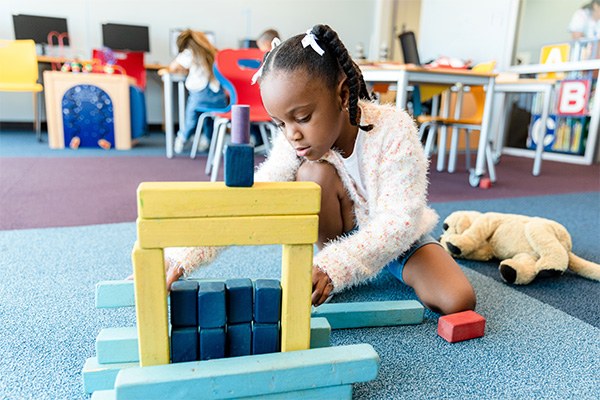Posted: September 1, 2022
Are you noticing that the children are playing with blocks a lot, but they are doing the same things over and over again? Having repeat experiences with the same materials is very important for children. They can get much joy from lingering in familiar play schemes, but sometimes children and teachers need a jump start to unsettle their play and their thinking.

If that's where you and your group is with block play, consider these less-conventional ways to include blocks in your daily curriculum plan:
- Use blocks as obstacles in an indoor or outdoor obstacle course or use them as objects in a relay race (i.e., run to a bucket, grab a block, return to the starting line).
- Allow infants and young toddlers to drop the blocks through a slot in a box lid and then enjoy shaking the box to experience weight and sound in a vigorous, fun physical activity.
- Wrap coarse sandpaper around a unit block to create a "sand block" for percussion OR for actual sanding in a woodworking area.
- Use a longer unit block as a nonstandard measuring tool.
- Add 1-, 2-, and 4-foot lengths of cove molding to the block play area to introduce slides, ramps, and other fun engineering possibilities.
- Give each seasoned builder a set of ten blocks, each set the same, and challenge each child to create a structure. See how different the structures are that the children build.
- Experiment with stacking plastic cups instead of blocks.
- Give older architects practice using a measuring tape. Measure the height, length, and width of their block worlds.
- Make it exciting. Change the "scale" of an experience. Build with very large or very small materials, challenging children's developing motor skills. Be vigilant if there are infants and toddlers present with small pieces (choking) and large (falling).

- Challenge children to create a ramp. Roll a ball down it to knock down a series of blocks (like a modified bowling activity).
- Combine blocks and other items to build a Rube Goldberg-like chain reaction contraption.
In all these "stretch" block adventures, the most important role for practitioners is to supervise closely. If you want some more ideas, check out these additional tip sheets.
Have fun building and encouraging fresh experiences with the blocks--one of the most-loved materials in the early childhood play setting!

